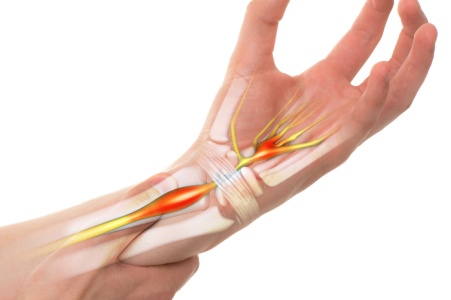Blog

Carpal tunnel syndrome affects the narrow passageway in the wrist where the median nerve travels into the hand. When this space becomes irritated or compressed, it can lead to abnormal sensations, tingling, pain in the fingers, or weakness during daily tasks. Common causes include overusing the hands, placing pressure on the wrist for long periods, or overstretching movements that strain the surrounding tissues. A chiropractor can help by improving wrist and spine alignment, reducing tension in the forearm muscles, and guiding safer movement patterns that relieve pressure on the median nerve. Early care can prevent symptoms from worsening. If you have wrist pain that is affecting your daily activities, it is suggested that you consult a chiropractor who can offer natural relief solutions that support healing and comfortable hand function.
Carpal Tunnel Syndrome
Carpal tunnel syndrome, or CTS, is a condition caused by compression of the median nerve, which runs through the carpal tunnel in the wrist. This tunnel is a narrow passageway surrounded by bones and ligaments, and when it becomes compressed or inflamed, it can put pressure on the nerve. Symptoms of CTS include tingling, numbness, weakness, and pain in the hand and fingers, often making simple tasks difficult and uncomfortable.
Chiropractic care offers a non-invasive approach to managing CTS by addressing alignment and reducing nerve pressure. Chiropractors start by evaluating the wrist, elbow, and even the cervical spine or neck, as misalignments in these areas can contribute to nerve compression in the wrist. Through gentle adjustments, chiropractors can improve the alignment of the wrist and spine, helping to reduce the pressure on the median nerve.
In addition to adjustments, chiropractors may use soft tissue therapy, such as stretching and myofascial release, to reduce inflammation surrounding the wrist and enhance mobility.
Why Consider Chiropractic for CTS?
Chiropractic care can provide lasting relief by targeting the root causes of CTS, reducing pain, and promoting long-term hand and wrist health.
Can Chiropractic Care Address Repetitive Strain as a Cause of CTS?
Chiropractic care can help manage repetitive strain by improving joint alignment and recommending ergonomic adjustments.
If you have any questions, please feel free to contact our office located in Sugar Land, TX .

Headaches can make it hard to focus, work, or enjoy daily life. They often come from tension in the neck and shoulders, poor posture, stress, or problems with how the spine and muscles function. When the neck or upper back is not properly aligned, it can place pressure on nearby nerves and muscles, leading to pain that travels to the head. Some headaches cause dull, steady aching, while others bring sharp or throbbing pain, sometimes with light or sound sensitivity. A chiropractor can help by improving spinal alignment and reducing tension that may be affecting the nerves and muscles connected to the head and neck. This can support better movement, circulation, and nerve function, which may help decrease headache frequency and intensity. If headaches are interfering with your day-to-day life, it is suggested that you schedule a visit with a chiropractor.
Headaches are a widespread issue, often caused by stress, poor posture, or tension in the neck and shoulders. They can range from dull, persistent discomfort to sharp, debilitating pain, interfering with daily activities and reducing quality of life. Muscle tension and joint misalignments in the cervical spine are frequent contributors to headaches, particularly tension and neck-related headaches. Ignoring these issues can result in recurring or worsening symptoms.
Chiropractic care offers a non-invasive, drug-free solution for headache relief. Chiropractors assess spinal alignment and posture to identify factors contributing to the pain. Treatment may include precise spinal adjustments to reduce pressure on nerves, relax tight muscles, and improve mobility.
1. Are headaches ever caused by issues in the lower spine?
While less common, misalignments in the lower spine can create compensatory issues throughout the body, including tension in the neck and shoulders, which may contribute to headaches.
2. How does chiropractic care address sinus headaches?
Chiropractors can perform gentle adjustments and soft tissue work around the neck and upper back to improve drainage and reduce sinus pressure, providing relief from sinus-related headaches.
If you have any questions please feel free to contact our office located in Sugar Land, TX .

Degenerative disc disease occurs when the spinal discs gradually lose flexibility, height, and cushioning ability, leading to pain and stiffness. It progresses through four stages. The beginning stage involves minor disc wear and reduced hydration. The prolapsed stage occurs when the disc starts to bulge outward. The herniated stage follows, where the disc’s inner material pushes through, irritating nearby nerves. In the severe stage, the disc collapses, causing chronic pain and limited movement. A chiropractor can assess spinal alignment, relieve pressure on affected discs, and improve mobility through gentle adjustments and therapeutic exercises. If you have persistent back or neck pain, it is suggested that you schedule an appointment with a chiropractor to restore spinal health through natural treatment solutions.
Degenerative Disc Disease
Degenerative disc disease, or DDD, is a condition characterized by the gradual wear and tear of the spinal discs, which act as cushions between vertebrae. As these discs deteriorate, they lose height, elasticity, and hydration, resulting in reduced shock absorption and increased friction between bones. This degeneration can lead to chronic pain, stiffness, and decreased mobility, often radiating to other areas of the body due to nerve irritation.
Management of Degenerative Disc Disease
Chiropractors manage degenerative disc disease by reducing stress on the spine and enhancing mobility to alleviate discomfort. They use targeted spinal adjustments to help improve alignment, which minimizes nerve compression and promotes better disc health. By restoring spinal balance, chiropractic care can help reduce pain and prevent further degeneration.
Complementary treatments like stretching exercises, strengthening routines, and postural training often accompany chiropractic adjustments to provide a comprehensive approach to managing DDD. These additional therapies aim to enhance flexibility, reinforce supporting muscles, and protect the spine from further strain.
Chiropractic care focuses on a non-invasive, holistic approach, offering relief without reliance on medication or surgery. By addressing the underlying mechanics of the spine, chiropractors work to help patients manage DDD symptoms effectively and enjoy improved quality of life over time.
1. How often should someone with degenerative disc disease see a chiropractor?
The frequency of visits varies based on individual needs, but patients often benefit from regular treatments initially, which can then be adjusted as symptoms improve or stabilize.
2. Will chiropractic care stop the progression of degenerative disc disease?
While chiropractic care cannot reverse the condition, it can help alleviate symptoms, reduce pain, and improve quality of life, making it easier to stay active, which may slow progression over time.
3. How does a chiropractor evaluate the progression of degenerative disc disease over time, and can they adjust their techniques as the condition evolves?
Chiropractors typically monitor changes in mobility, pain levels, and overall function, adjusting their treatment plans to accommodate increased sensitivity or stiffness as the disease progresses.
4. Does chiropractic care provide long-term relief for degenerative disc disease?
While chiropractic care may not cure degenerative disc disease, regular treatment can offer long-term relief by managing pain, reducing inflammation, and improving joint mobility, which can enhance quality of life over time.
If you have any questions please feel free to contact our office located in Sugar Land, TX .

Stress and low energy often result from an imbalance in the autonomic nervous system, which regulates involuntary bodily functions such as heart rate, digestion, and sleep. When misalignments in the spine interfere with nerve communication, they can disrupt balance, leading to heightened stress responses and fatigue. A chiropractor can help by assessing spinal alignment and identifying areas where nerve interference may be occurring. Through precise spinal adjustments, a chiropractor aims to restore proper nerve function, which may help normalize autonomic nervous system activity. This restoration can support the body's ability to manage stress more effectively and improve energy levels. Patients often report feeling more relaxed, experiencing better sleep, and having increased vitality following chiropractic care. If you are experiencing stress and looking for a natural treatment option, it is suggested that you schedule an appointment with a chiropractor for an evaluation.
Experiencing ongoing stress and low energy can wear down both body and mind, making even routine tasks feel overwhelming. The body’s stress response, designed for short bursts of activity, can exhaust physical and mental reserves when constantly activated, leaving a feeling of fatigue and burnout.
Chiropractic care offers a supportive way to manage these challenges by focusing on the body's alignment and nervous system function. Misalignment in the spine can increase tension, disrupting nerve signals and possibly contributing to feelings of low energy. Gentle adjustments can help relieve this tension, supporting better nervous system communication, which may encourage relaxation and boost energy levels.
Incorporating chiropractic care into a wellness routine can offer a holistic approach to managing stress and low energy, emphasizing balance, relaxation, and overall vitality for a more energized and resilient life.
1. How does stress affect the spine, and how can chiropractic care help?
Stress often leads to muscle tension and poor posture, which strain the spine. Chiropractic adjustments relieve this tension and promote better alignment.
2. How does chiropractic care improve sleep for better energy levels?
Adjustments relieve pain and tension, making it easier to fall asleep and stay asleep. Better rest directly boosts energy and resilience to stress.
If you have any questions please feel free to contact our office located in Sugar Land, TX .
